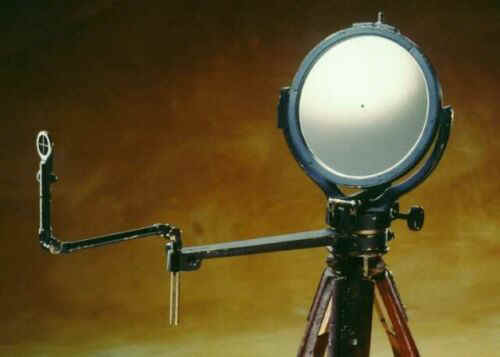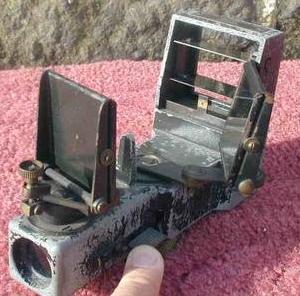|
This website is dedicated to the
preservation and furtherance of the art of Heliography, or using mirrors for
communications. Because the site contains considerable material on the heliograph
and will be regularly updated, you may want to bookmark it for further reference.
You are encouraged to browse
through the information presented, and your comments will be appreciated.

There are Three Basic Models of
Heliographs:
 |
BRITISH 5" MARK V MANCE HELIOGRAPH WITH
SIGHT |
|
The sight is used when both the distant station and the sun are in front of the
heliograph. The sight is replaced with a second mirror (called a "duplex"
or "station mirror") when the sun is to the rear of the heliograph. A
"key" located on the back side of the heliograph, when depressed, tilts the
mirror upwards, thereby directing the reflected sun's flash onto the distant
station. The heliograph operator uses the dots and dashes of Morse Code for sending
messages just as would a telegraph operator. The original model was invented
by Sir Henry C. Mance of Karachi, Bombay, his application being filed with the US Patent
Office in February, 1876. In some 1880's British Army photos, the mirrors appear to
be 10" or 12" in diameter instead of 5". |
 |
AMERICAN SERVICE HELIOGRAPH, 4" or more
The basic difference between the British and the American models is that the American sun
mirror (below left) remains fixed rather than being tilted, as with the Mance when
transmitting. Therefore it is the shuttered screen (bottom right) that is
"keyed" instead of the mirror. The heliograph in the upper drawing is
equipped with a station (or duplex) mirror. Below it is the same heliograph using a
sight in lieu of the station mirror. The screen to its right is mounted on a second
tripod and is used with either setup. The operator "keys" the screen
downward, thereby allowing the reflected sun's rays to pass to the distant station.
Again, the short and long flashes of Morse Code are used. The model above was
probably invented prior to 1881. Later, screens were of four or six blades for more
rapid sending. |

|
PORTUGUESE 1 1/2"
HELIOGRAPH
This little instrument is a
totally different "breed of cats". Combined into a single unit are the
simplex and duplex mirrors, a sighting tube with crosshairs, and a two blade screen.
The simplex mirror is on the left. The unit mounts onto a tripod, but appears that
the tripod would have to be perfectly set to align the crosshairs with the distant
station. A second aiming device is with a little hole in the 1" high post that
allows the sun to be reflected off the bottom of the simplex through the little hole onto
1/4" white crosshairs on the tab just below the shutters. This "sun
spot" replaces the "shadow spot" found on other models. Unlike the British
and American models, the unit does not have to be reversed when switching between simplex
and duplex. By the way, I recently purchased one of these. It looks
rough but is in good working condition. I hope to restore and put it back to work
(play?). Photo is through the courtesy of Pastor David Shephard of Portugal whose
finger is holding open the shutter. |
Please see the "Definitions" page for information on the operation of the
Heliograph.
|

|